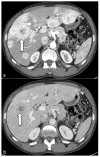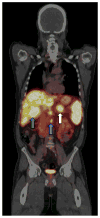Biochemical Diagnosis and Preoperative Imaging of Gastroenteropancreatic Neuroendocrine Tumors
- PMID: 26610781
- PMCID: PMC4663658
- DOI: 10.1016/j.soc.2015.08.008
Biochemical Diagnosis and Preoperative Imaging of Gastroenteropancreatic Neuroendocrine Tumors
Abstract
Neuroendocrine tumors are a group of neoplasms that can arise in a variety of locations throughout the body and often metastasize early. A patient's only chance for cure is surgical removal of the primary tumor and all associated metastases, although even when surgical cure is unlikely, patients can benefit from surgical debulking. A thorough preoperative workup will often require multiple clinical tests and imaging studies to locate the primary tumor, delineate the extent of the disease, and assess tumor functionality. This review discusses the biomarkers important for the diagnosis of these tumors and the imaging modalities needed.
Keywords: Carcinoid; Gut hormones; OctreoScan; Pancreas neuroendocrine tumors.
Copyright © 2016 Elsevier Inc. All rights reserved.
Figures





References
-
- Yao JC, Hassan M, Phan A, et al. One hundred years after “carcinoid”: epidemiology of and prognostic factors for neuroendocrine tumors in 35,825 cases in the United States. J Clin Oncol. 2008;26(18):3063–3072. - PubMed
-
- Pearse AGE. Common cytochemical properties of cells producing polypeptide hormone, with particular reference to calcitonin and the thyroid C cells. Vet Rec. 1966;79:587–590. - PubMed
-
- Klimstra DS, Modlin IR, Coppola D, Lloyd RV, Suster S. The Pathologic Classification of Neuroendocrine Tumors: A Review of Nomenclature, Grading, and Staging Systems. Pancreas. 2010;39:707–712. - PubMed
-
- Solcia E, Kloppel G, Sobin LH. WHO International Classification of Tumours. 2. New York: Springer; 2000. Histological Typing of Endocrine Tumors.
-
- Lamberts SW, van der Lely AJ, de Herder WW, Hofland LJ. Octreotide. N Engl J Med. 1996;334(4):246–254. - PubMed
Publication types
MeSH terms
Substances
Supplementary concepts
Grants and funding
LinkOut - more resources
Full Text Sources
Other Literature Sources
Medical

